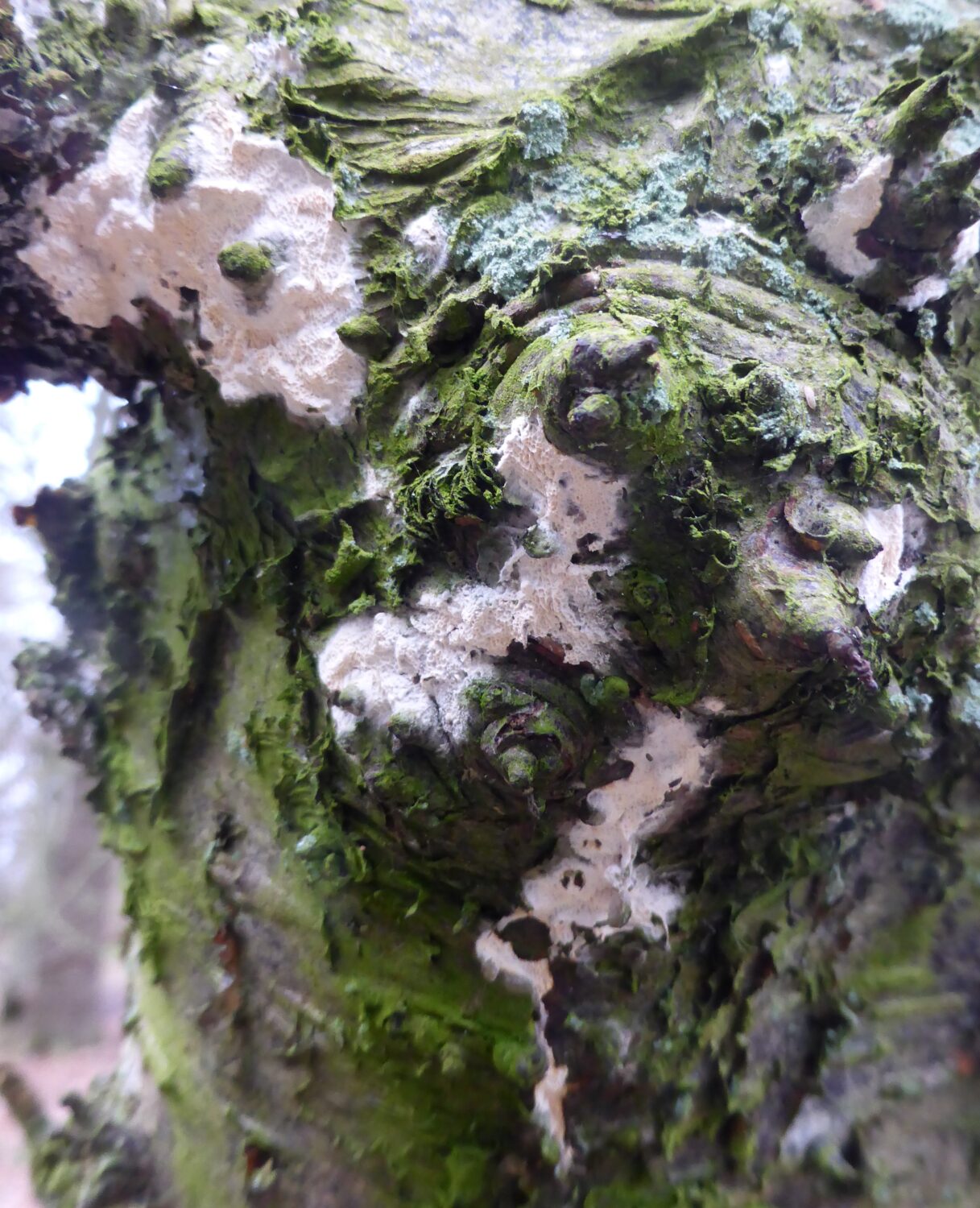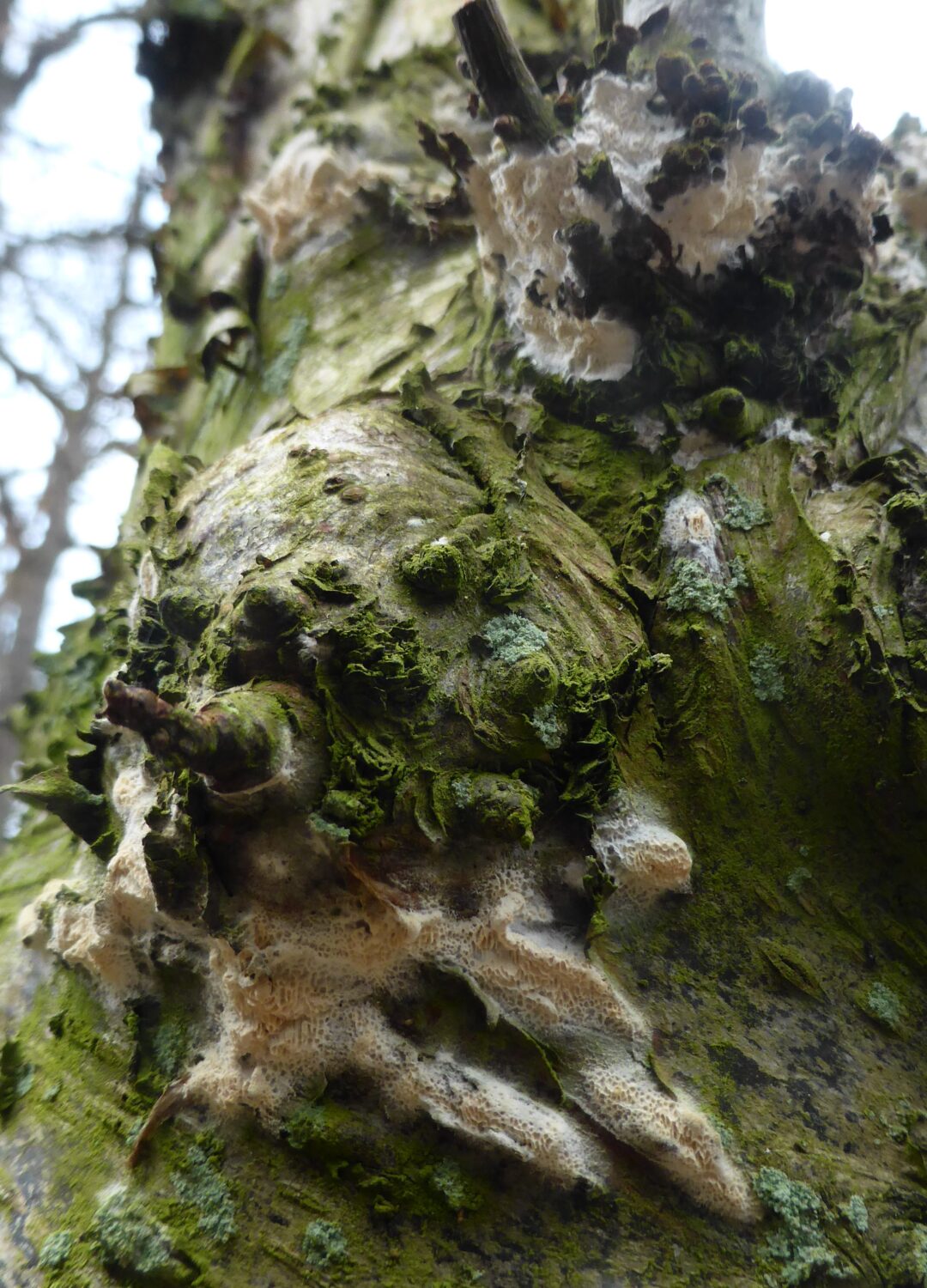Explore a tale of beginner’s luck, expert support, and sound woodland stewardship as local naturalist, Lydia Koelmans, shares the discovery of Porotheleum fimbriatum at Gosforth Nature Reserve.
While doing Volunteer Ranger lockdown patrols of Gosforth Nature Reserve in January 2021, on a whim I photographed a fungus. In plain sight from the path, it was growing in some quantity up the trunk of a standing, dead Silver Birch, in the form of pale pink crusty patches. Since I can identify only a small minority of fungi that are common and distinctive, I never imagined that this might be anything special, and so I did not take a Grid Reference.
Nonetheless keen to increase my knowledge, I sent my picture to a fellow member of the Botany Group, but whose main interest is fungi, and it was looked at by local experts in mycology.
The answer came back: This is an interesting one! I think it is a resupinate polypore and the only species that I can find in Volume 2 of the Fungi of Temperate Europe is Physisporinus vitreus which looks a good match on pictures alone. It seems the only record on Cate2 for vc67 is from Bedlington in 1999. It has been recorded from vc66 and 68, but only rarely – so yes, it should be recorded.

This was hugely encouraging to me, to have found a fungus that my Collins Fungi Guide describes as mainly southern, and uncommon. I would however need a Grid Reference to be able to record it. A couple of weeks passed, during which time I was hampered in my search, by atrocious weather, floods, freezing temperatures, snow and ice, driving cold rain, and woody debris clattering down from the canopy – plus my bad memory. After several fruitless attempts, I was no longer even sure in which parts of the Reserve I had been, on 24 January, and I started to worry as to just how many standing dead birch trees there might be in the Reserve! Finally, I re-found the right tree. Phew.
Physisporinus is described as occurring on very wet, rotting, woody debris (often fallen wood), whereas this host tree is standing, dry and brittle. Also, fungi of this genus may undergo some colour change on bruising (which did not seem to be the case with mine). So as to resolve any lingering doubts, local expert Doug McCutcheon very kindly braved the snow and visited the site with me, on 7 February.
A couple of days later, I received the following very exciting news:
Your fungi is not Physisporinus vitreus but is a really nice find which I am as sure as I can be that it is Porotheleum fimbriatum. It is in a group of its own intermediate between cyphelloid fungi which have hanging cups or tubes and resupinate polypores. In this case, the tubes have fused and it resembles the latter.
Your photograph shows many warty protuberances which when we saw the tree it was clear that the fungus had overgrown the stubs of the epicormic twigs that have arisen from the burrs on the birch trunk causing these uneven lumps which had led me to Physisporinus. Microscopic examination ticks all the boxes and in conjunction with the fimbriate margin of white hyphal cords (which is clear in your picture) there is little doubt that it is Porotheleum fimbriatum.
There are only a handful of records in the UK the nearest being West Yorkshire also found in February about 3/4 years ago by our Yorkshire colleague Archie McAdam although it should be in best condition before December.
Porotheleum fimbriatum is of sufficient rarity that it does not even feature among the 2,400+ species given in my Collins, The Most Complete Field Guide to the Mushrooms and Toadstools of Britain and Ireland. I could not have begun to identify it on my own. Finds like this, really vindicate the management policy of leaving so much deadwood in Gosforth Nature Reserve, and demonstrate that NHSN is protecting biodiversity.
